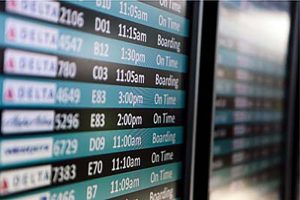When faced with a delay, checking earlier flights for delays might be an option.

This week I had a client taking a 3 p.m. flight from San Francisco to Newark on United Airlines. However, at about 10 a.m. United announced the flight would be delayed until 5:30 p.m., meaning he wouldn’t arrive until 1:30 a.m. My client had an early-morning meeting in New York City, which meant he was looking at a very short night of sleep.
United’s next flight was at 4:20 p.m. and the noon and 1:05 p.m. flights, which he told me realistically would be hard to make anyway, were full. Plus, standby was not a sure thing, but also would probably mean a middle seat at best. So the 4:20 p.m. flight, while not ideal, seemed like the best bet, even though it was showing slightly delayed.
On the other hand, since San Francisco has so many delays, even though there were no weather issues, I decided to think backwards. I started checking the other, earlier flights. Sure enough, while some flights were more or less on time, the 11 a.m. flight was scheduled to be over three hours late.
The delay was for an incoming flight not even due to arrive until 1:30 p.m., which meant the chances of the inbound flight making up time were slim. I asked my client if he could make a 2:00 p.m. or so flight and he said yes. So, I called United to verify, telling them he couldn’t make it to the airport before about 1 p.m. The agent agreed with me and cheerfully rebooked him on the 11 a.m., with an excellent exit row seat assignment.
Curiously enough, he also told me the flight didn’t end up completely full, while other afternoon flights had long standby lists. I believe the reason is that airline reservations systems show scheduled times, not actual times, and it requires a second step to think backwards, checking what is called in airline jargon, “FLIFO” (Flight information), at least to see when a flight actually is supposed to depart in real time. Meaning that anyone trying to rebook a delayed afternoon departure might not realize that a morning departure might have become an afternoon departure.
For travelers at the airport facing delays, in some cases, your best bet might be a flight that should have already left. Personally, I’ve avoided a five-hour delay to Newark and a shorter Las Vegas delay last year by thinking this way. While afternoon options were full, planes that were supposed to have left 1-2 hours before I got to the airport were still at the gate, with plenty of empty seats. (The only potential issue with these changes at the airport is that passengers with checked bags are usually not permitted to change to different flights, so if you have luggage, check about changes at the front counter.)
Airline reservations agents see the same availability that travel agents and travelers using OTA (online travel agents) and other reservations systems do. So, you may have to get them to verify the delay before they will change your ticket. If it’s a flight scheduled to have left already, your only option might be the airport, as the reservations systems generally don’t have the technology to book flights past scheduled departure.
While this system doesn’t always work, the think backwards technique has saved my clients and me on many, many occasions. Most travelers, when faced with a flight problem, start looking for the next flights, not previous flights.
However, when looking at a long delay or even a cancellation, think backwards. Or, ask your travel agent to look. It might take a few minutes, but it could save you more than a few hours.
Janice Hough is a California-based travel agent a travel blogger and a part-time comedy writer. A frequent flier herself, she’s been doing battle with airlines, hotels, and other travel companies for over three decades. Besides writing for Travelers United, Janice has a humor blog at Leftcoastsportsbabe.com (Warning, the political and sports humor therein does not represent the views of anyone but herself.)



